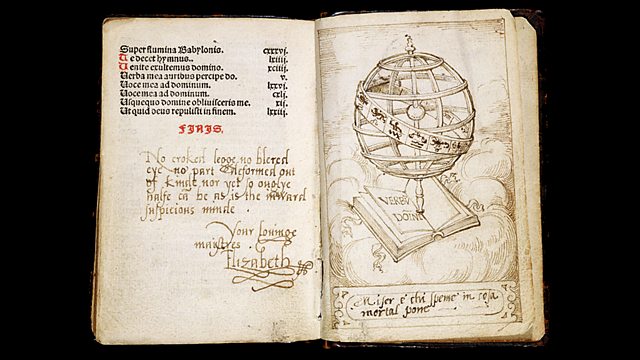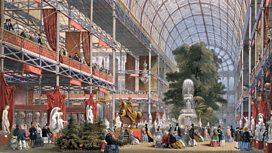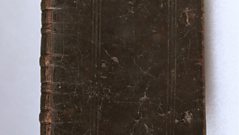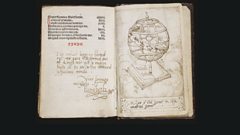Progress
Will Gompertz explores the relationship the institution of the monarchy has had with change. From March 2012.
The Royal Collection is one of the most wide-ranging collections of art and artefacts in the world and provides an intriguing insight into the minds of the monarchs who assembled it.
During the series, Will Gompertz encounters dozens of these unique objects - some priceless, others no more than souvenirs - each shedding light on our relationship with the monarchy and giving a glimpse into the essential ingredients of a successful sovereign.
In this programmes, Will explores the relationship the institution of the monarchy has had with that potentially corrosive agent - change. He finds that the most successful monarchs have understood and harnessed innovation - Henry VIII took an interest in wood so the Navy boats would be the best on the ocean, Charles II established the Royal Observatory so astronomers could find out more about the skies and better inform navigation. Queen Victoria asked Marconi to demonstrate a radio station at Osborne House and she took part in the first trans-Atlantic cable ever sent.
With the help of objects and curators from the Royal Collection, together with leading historians, Will studies objects that not only demonstrate the patronage of the arts and sciences but also illuminate the more personal expressions of learning and monarchical intellectual engagement.
Producer: Sarah Taylor.
Last on
More episodes
Previous
![]()
Listen to a selection of programmes and clips related to The Art of Monarchy: Progress
Clips
-
![]()
Psaultier de David - audio clip
Duration: 00:56
-
![]()
The Art of Monarchy - Progress
Duration: 00:56
-
![]()
Psaultier de David with inscription by Elizabeth I
Duration: 01:20
The Psaultier de David, with an inscription by Elizabeth I

The Psaultier de David, containing an inscription by Elizabeth I (1533-1603). All Henry VIII's children were provided with a thorough education based on continental humanist principles which included instruction in the new Italic hand.
听
From: Presented to Her Majesty The Queen, when Princess Elizabeth, in 1947 听
Date: c.1550 听
Material: Bound in black calfskin 听
Size: 132 x 91 mm 听
听
听
听
Royal Greenwich Observatory, commissioned by Charles II, 1675

The great star or octagon room at the Royal Greenwich Observatory. The Observatory was commissioned by Charles II in 1675 at the same time as creating the position of Astronomer Royal. In this room observations were taken using instruments including the sextant and telescope. Portraits of Charles II and James II can be seen on the wall.
听
From: England 听
Date: 1675
听
听
听
听
听
Blue john perfume vase and candelabra

Perfume vase and candelabra, designed by Matthew Boulton (1728-1809) and Sir William Chambers (1723-1796). Boulton's Birmingham workshops developed manufacturing techniques that enabled them to produce luxury objects at a lower cost.
听
From: England.Purchased by George III 听
Date: 1770-1 听
Material: Blue john, gilt bronze, ebony 听
Size: 571 x 552 x 178 mm
听
听
听
听
The first message sent by transoceanic cable, from Queen Victoria to the President of the USA

Ticker tape containing the first message sent by transoceanic cable, from Queen Victoria (1819-1901) to James Buchanan (1791-1868) President of the United States of America. The laying of a transatlantic telegraph cable enabled communications to reach America in a matter of minutes, rather than days.
听
From: Presented to Queen Victoria
Date: 8/16/1858
Material: Ink on paper
Size: 65 x 310 x 35 mm
听
听
听
The Great Exhibition: Moving Machinery

The Great Exhibition: Moving Machinery, lithograph after a 1851 watercolour by Louis Haghe (1806-85). Prince Albert played a leading role in planning the Great Exhibition, and commissioned a series of watercolours to record the occasion.
听
From: England. Published in Dickinsons' Comprehensive Pictures of the Great Exhibition of 1851, Volume II, 1854
Date: 1854
Material: Lithograph
听
听
听
听
The first televised Royal Christmas Message, December 25th 1957.

A photograph taken at the first televised Royal Christmas Message, December 25th 1957 from the Long Library at Sandringham House. The Queen holds a copy of Bunyan's Pilgrim's Progress which she quoted from during her Christmas speech.
听
From: England Date: 1957
Material: Gelatin silver print
听
听
听
More from Radio 4: Thomas Cromwell

Historian and author Derek Wilson proposes 16th century politician Thomas Cromwell who ran the country for Henry VIII, and was eventually beheaded. Presenter Francine Stock and Professor Diarmaid MacCulloch discuss it with him.
听
More from Radio 4: The Great Exhibition of 1851

Melvyn Bragg and guests discuss the 1851 Great Exhibition. How did the Exhibition crystallise a particular moment in early Victorian Britain? In what way did it capitalise on the dawn of mass travel and greater levels of international co-operation? How did fears of revolutionary Europe define the policing and organisation of the event? And how far, if at all, did the Great Exhibition go in blurring class distinctions?
听
More from Radio 4: Henry VII

Series of biographical discussions with Matthew Parris. Shadow Chancellor George Osborne nominates Henry VII, founder of the Tudor dynasty. By making the crown much less financially independent on the nobles, he claims that Henry played a key role in establishing the processes of modern government. Studio guest Dr Steven Gunn helps to assess whether Osborne is right.
听
Broadcasts
- Sat 17 Mar 2012 10:30大象传媒 Radio 4
- Sat 2 Sep 2017 07:30大象传媒 Radio 4 Extra
- Sat 2 Sep 2017 17:30大象传媒 Radio 4 Extra
- Sun 3 Sep 2017 05:30大象传媒 Radio 4 Extra
Podcast
-
![]()
The Art of Monarchy
Will Gompertz examines objects in the Royal Collection that define the British monarchy.







